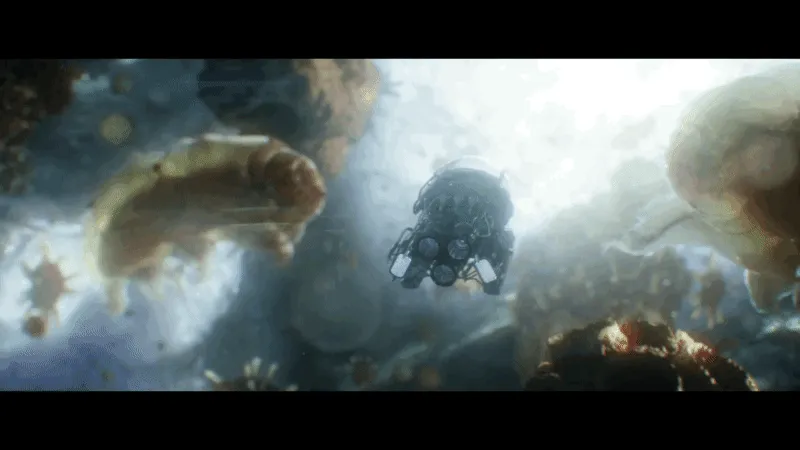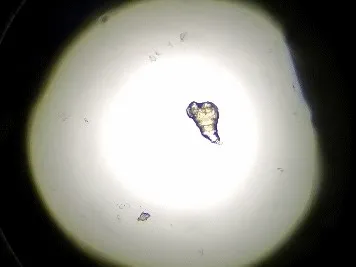Be Very, Very Quiet...
Posted:
This week we are celebrating Science Literacy Week all across Canada! The theme this year is biodiversity, an excellent opportunity for Nature Exchange to explore a new part of nature. To celebrate, I examined some of the biodiversity within The TELUS World of Science Centre - Edmonton's backyard (otherwise known as Coronation Park). Some organisms were easy to find but others were much, much harder.
One of the most plentiful, and hardest to find, is the microscopic master of disguise, the tardigrade.
Written by: Addison Schaub, Science Presenter (Nature Exchange)
So... What is a Tardigrade?
A tardigrade, sometimes called a water bear or moss piglet, is a micro-organism that can be found all around the planet. Tardigrades can survive in many extreme conditions; extremely high and low temperatures, environments with little or no air, radiation, dehydration, and starvation, any of which would be able to kill most other life forms. Incredibly, they are also able to survive the vacuum of space! There are approximately 1,300 species of tardigrade that can be found across the planet, from the tops of mountains to the bottom of the oceans, and from tropical rainforests to Antarctica. These cool little critters are mystifying enough to be featured in Marvel’s Ant-Man and Star Trek: Discovery!

Tardigrades surrounding Dr. Hank Pym’s ship to the quantum realm in Ant-Man and the Wasp ((c) Marvel, 2018).
Tardigrades are approximately 0.5 mm long and can be easily found with even a low powered microscope. If you’re looking to hunt some tardigrades of your own, look for them in mosses and lichens where they like to live.
But, Where Do I Find Moss and Lichen?
Mosses and lichens thrive in moist and shaded conditions. Because of this, they grow on the ground, on fallen trees, and even on living trees. Believe it or not, moss doesn’t only grow on the north side of a tree. While this is generally true in the northern hemisphere, it is only because the north side is exposed to less sunlight and is therefore more shaded and moist. In the southern hemisphere the opposite is true, mosses and lichens usually grow on the south side of objects for the same reason. But in both cases, mosses will grow while facing in any direction as long as the growing conditions are right.
My Hunt for the Elusive Water Bear

Yellow, crusty lichen growing on a tree.

Patch of moss on the ground between a group of trees.
If I was going to find some tardigrades, I needed to find some moss and lichen. My first stop was a tree between the TWOSE parking lot and 142 Street with a yellow, crusty lichen growing on it that I had seen earlier that morning.
As I continued around the park, I was having a hard time finding any moss growing on the trees. I had started to get concerned that the park might be the wrong place to find tardigrades. But as it turns out, all I had to do was look down. I found my first patch of moss at the boundary between the grass and the dirt surrounding the trees.

White-tailed jackrabbit taking a break after running away from me.

Worm living in a moss sample I collected.
Continuing my search, I came face-to-face with this white-tailed jackrabbit that came darting out of the trees. This animal was much too large to be the tardigrade that I was looking for.
My next moss sample was found in front of the Peter Hemingway Fitness and Leisure Centre, growing on a gravel and cement retaining wall. This moss even had an invertebrate living in it – though the worm ended up a bit fuzzy in my picture.

A crow that I encountered in Coronation Park.
On my way back to the Nature Exchange, I was surrounded by the chattering of red squirrels. The loud chattering was their way of asserting their dominance over the territory I was walking through. I wasn’t the only trespasser invading their space, this crow, and several others like it, were flying around the park in search of something to eat. Unfortunately, none of these animals brought me closer to my goal of finding the elusive tardigrade.
After returning to the Nature Exchange, it was time to examine my samples to see if they contained any tardigrades. I ran dechlorinated water through the moss and lichen to rehydrate them and shake loose anything living in them. It was really important to use dechlorinated water because the chlorine in tap water is enough to kill many micro-organisms in the samples. After removing the moss from the water, I used a pipette to collect the debris that had been washed out and examined it under a microscope.

Compound microscope and moss samples ready for the hunt to begin!

One of many rotifers found in the second sample.
The first sample I examined, the lichen, didn’t have much to find, just a lot of detritus (also known as dead stuff).
In the second sample, I was also able to find a number of rotifers. Rotifers are a micro-organism that live in freshwater and marine environments and, like tardigrades, can be found all around the world. A rotifer is identified by the wheel-like ring of cilia, hair-like structures used for movement, which forms the basis of their name (“rota-” wheel “-fer” bearing). The rotifers I found were crawling along the glass very similar to a tiny worm. Next to one of these rotifers, I found my first trace of a tardigrade! It was only the remains of a dead tardigrade and while it’s not what I was looking for - it let me know that I was on the right track!
In the third sample, I found rotifer, after rotifer, after rotifer, after rotifer, after rotifer, after rotifer, and another rotifer, after rotifer, still a rotifer, more rotifers, nothing but rotifers, and a rotifer, another rotifer, guess what? Rotifer! Rotifer. Rotifer. Look... another rotifer, rotifer, tardigrade, rotifer. Wait. What? Finally! A TARDIGRADE!These tiny animals are not easy to spot.

Tardigrade at 400x magnification.
Can you find the tardigrade hiding amongst all of the detritus?
Hint 1: You can identify tardigrades by their 8 legs, each with long claws on the ends.
Hint 2: This tardigrade is lying on its back with its feet in the air.
It wasn’t long after that I found even more tardigrades, bringing my hunt for one of the smallest members of Edmonton’s animal kingdom to a close.
Not only did I find tardigrades, but in the process I also discovered many plants and animals living in Coronation Park. The jackrabbit probably scared me just as much as I scared it.
What a great way to celebrate our local biodiversity and Science Literacy week!
Are you ready to go on your own tardigrade hunt?

This tardigrade is 'walking' along a piece of detritus.
Here’s what you’ll need:
- A microscope
- A pipette or an eyedropper
- Dechlorinated water (tip: bottled water works great!)
- Moss or lichen
Find your own mosses in the park nearest you, or any natural areas such as fences in residential areas. You can follow the same process I used to find tardigrades in my hunt or experiment with your own.
Be sure to let us know if you found anything interesting by tagging #MyTWOSE on Social Media!
#MyTWOSE #SciLitWeek2020 #SciLit
Related Articles


Food Chain Reactions
How Climate Change is Impacting Canada's Lakes


Why I Became A Psychologist Who Studies Animals
A guest post by Dr. Lauren Guillette, TWOSE Science Fellow, for Science Literacy Week 2020. Lauren discusses why she became a psychologist who studies animals and her favourite science books.


#TWOSEreads
A collection of book recommendations from our staff in celebration of Science Literacy Week 2020.
Related Articles


Food Chain Reactions
How Climate Change is Impacting Canada's Lakes


Why I Became A Psychologist Who Studies Animals
A guest post by Dr. Lauren Guillette, TWOSE Science Fellow, for Science Literacy Week 2020. Lauren discusses why she became a psychologist who studies animals and her favourite science books.


#TWOSEreads
A collection of book recommendations from our staff in celebration of Science Literacy Week 2020.





